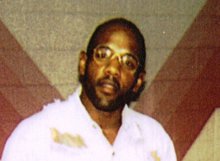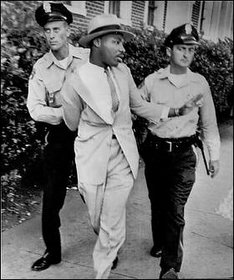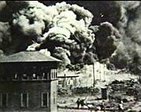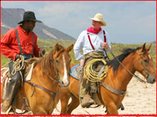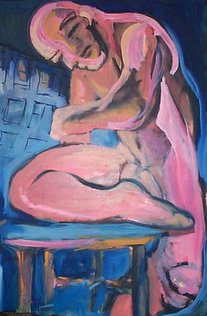
Even though the Blacks were given freedom with amendments to the constitution. Discrimination was still legally taking place in the southern and border states. Legal only in the fact that they had the law on their side. When you look at the guilty states and their various Jim Crow laws. You can see laws were designed and enforced to keep the Blacks in inferior status. If you read the list below containing the guilty states, and their respective laws. It was evident that these laws were enacted to deny free Blacks equality. Violation could result in imprisonment, fines, or even phuysical whippings. Depending on the discretion of the judges, even all three.
An African American drinks out of a segregated water cooler designated for "colored" patrons in 1939 at a streetcar terminal in Oklahoma City

The following is a list of the states and their laws.
Alabama
"Buses. All passenger stations in this state operated by any motor transportation company shall have separate waiting rooms or space and separate ticket windows for the white and colored races."
"Railroads. The conductor of each passenger train is authorized and required to assign each passenger to the car or the division of the car, when it is divided by a partition, designated for the race to which such passenger belongs."
Arkansas[1]
Intermarriage/Cohabitation: Various laws from 1884 to 1947 prohibited marriage or sexual relations between whites and blacks or mullatoes, providing for specific fines and even imprisonment up to three years.
Public Accommodations: Various laws from 1891 to 1959 segregated rail travel, streetcars, buses, all public carriers, race tracks, gaming establishments, polling places, washrooms in mines, tuberculosis hospitals, public schools and teachers' colleges.
Poll tax imposed in 1947.
Florida
Intermarriage. All marriages between a white person and a Negro, or between a white person and a person of Negro descent to the fourth generation inclusive, are hereby forever prohibited.
Cohabitation. Any Negro man and white woman, or any white man and Negro woman, who are not married to each other, who shall habitually live in and occupy in the nighttime the same room shall each be punished by imprisonment not exceeding twelve (12) months, or by fine not exceeding five hundred ($500.00) dollars.
Education. The schools for white children and the schools for Negro children shall be conducted separately.
The following is a list of legislation and penalties dealing with racial relations in Florida, some in effect until 1967:
1865: Railroad [Statute] — Negroes or mulattoes who intruded into any railroad car reserved for white persons would be found guilty of a misdemeanor and, upon conviction, sentenced to stand in the pillory for one hour, or to be whipped, not exceeding 39 stripes, or both, at the discretion of the jury." Whites faced the same penalty for entering a car reserved for persons of color.
1873: Barred public accommodation segregation [Statute] — Prohibited discrimination on account of race in the full and equal enjoyment of public accommodations such as inns, public transportation, theaters, schools, cemeteries and places of public amusement. Did not include private schools or cemeteries established exclusively for white or colored persons.
1881: Miscegenation [Statute] — Unlawful for any white person to intermarry with any Negro person. Penalty: Performing such a ceremony punishable by a fine of $1,000, "of which one-half shall be paid to the informer."
1885: Education [Constitution] — White and colored children shall not be taught in the same school.
1885: Miscegenation [Constitution] — "Forever" prohibited marriages between whites and blacks, or between a "white person and a person of Negro descent to the fourth generation inclusive."
1887: Railroads [Statute] — "All respectable Negro persons" to be sold first-class tickets at the same rates as white passengers and shall be provided a separate car "equally as good and provided with the same facilities for comfort as for white persons." Penalty: Conductors and railroad companies violating the provisions of the law faced a fine up to $500.
1887: Education [Constitution] — White and colored children prohibited from being taught in the same schools.
1895: Education [Statute] — Penal offense for any persons to conduct any school, any grade, either public or private where whites and blacks are instructed or boarded in the same building, or taught in the same class by the same teachers. Penalty: Between $150 and $500 fine, or imprisonment in the county jail between three and six months.
1903: Miscegenation [Statute] — Intermarriage with a Negro, mulatto, or any person with one-eighth Negro blood shall be punished. Penalty: Imprisonment up to ten years or a fine not more than $1,000.
1905: Streetcars [Statute] — Separation of races required on all streetcars. Gave Caucasian mistresses the right to have their children attended in the white section of the car by an African nurse, but withheld from an African woman the equal right to have her child attended in the African section by its Caucasian nurse.
1907: Railroads [Statute] — Separate waiting rooms for each race to be provided at railroad depots along with separate ticket windows. Also called for separation of the races on streetcars. Signs in plain letters to be marked "For White" and "For Colored" to be displayed. Penalties: Railroad companies that refused to comply with the provision could be fined up to $5,000.
1909: Railroads [Statute] — Separate accommodations required by race. Penalty: Passengers who failed to comply with law would be fined up to $500.
1913: Education [Statute] — Unlawful for white teachers to teach Negroes in Negro schools, and for Negro teachers to teach in white schools. Penalty: Violators subject to fines up to $500, or imprisonment up to six months.
1927: Education [Statute] — Criminal offense for teachers of one race to instruct pupils of the other in public schools.
1927: Race classification [Statute] — Defined the words "Negro" or "colored person" to include persons who have one eighth or more Negro blood.
1941: Voting rights protected [Statute] — Poll tax repealed.
1944: Miscegenation [Statute] — Illegal for whites and Negroes to live in adultery. Penalty: up to $500, or up to two years imprisonment.
1945: Antidefamation [Statute] — Unlawful to print, publish, distribute by any means, any publications, handbills, booklets, etc. which tends to expose any individual or any religious group to hatred, contempt, ridicule, or abuse unless the name and address of those doing so is clearly printed on the written material.
1958: Education [Statute] — County boards of education may adopt regulation for closing schools during emergencies. Schools to close automatically when federal troops used to prevent violence.
1958: Public Carrier [Statute] — Races to be segregated on public carriers.
1967: Public accommodations [City Ordinance] — Sarasota passed a city ordinance stating that "Whenever members of two or more…races shall…be upon any public…bathing beach within the corporate limits of the City of Sarasota, it shall be the duty of the Chief of police or other officer…in charge of the public forces of the City...with the assistance of such police forces, to clear the area involved of all members of all races present."
Georgia
Restaurants. All persons licensed to conduct a restaurant, shall serve either white people exclusively or colored people exclusively and shall not sell to the two races within the same room or serve the two races anywhere under the same license.
Amateur Baseball. It shall be unlawful for any amateur white baseball team to play baseball on any vacant lot or baseball diamond within two blocks of a playground devoted to the Negro race, and it shall be unlawful for any amateur colored baseball team to play baseball in any vacant lot or baseball diamond within two blocks of any playground devoted to the white race.
Louisiana
Housing. Any person who shall rent any part of any such building to a Negro person or a Negro family when such building is already in whole or in part in occupancy by a white person or white family, or vice versa when the building is in occupancy by a Negro person or Negro family, shall be guilty of a misdemeanor and on conviction thereof shall be punished by a fine of not less than twenty-five ($25.00) nor more than one hundred ($100.00) dollars or be imprisoned not less than 10, or more than 60 days, or both such fine and imprisonment in the discretion of the court.
Mississippi
Promotion of Equality. Any person...who shall be guilty of printing, publishing or circulating printed, typewritten or written matter urging or presenting for public acceptance or general information, arguments or suggestions in favor of social equality or of intermarriage between whites and Negroes, shall be guilty of a misdemeanor and subject to fine or not exceeding five hundred (500.00) dollars or imprisonment not exceeding six (6) months or both.
North Carolina
Textbooks. Books shall not be interchangeable between the white and colored schools, but shall continue to be used by the race first using them.
Libraries. The state librarian is directed to fit up and maintain a separate place for the use of the colored people who may come to the library for the purpose of reading books or periodicals.
Virginia
Theaters. Every person...operating...any public hall, theater, opera house, motion picture show or any place of public entertainment or public assemblage which is attended by both white and colored persons, shall separate the white race and the colored race and shall set apart and designate...certain seats therein to be occupied by white persons and a portion thereof , or certain seats therein, to be occupied by colored persons.
Railroads. The conductors or managers on all such railroads shall have power, and are hereby required, to assign to each white or colored passenger his or her respective car, coach or compartment. If the passenger fails to disclose his race, the conductor and managers, acting in good faith, shall be the sole judges of his race.
South Carolina
Lunch Counters
No persons, firms, or corporations, who or which furnish meals to passengers at station restaurants or station eating houses, in times limited by common carriers of said passengers, shall furnish said meals to white and colored passengers in the same room, or at the same table, or at the same counter.
Child Custody
It shall be unlawful for any parent, relative, or other white person in this State, having the control or custody of any white child, by right of guardianship, natural or acquired, or otherwise, to dispose of, give or surrender such white child permanently into the custody, control, maintenance, or support, of a negro.
Other states
Alabama, Arizona, Florida, Georgia and Kentucky [2]
Louisiana, Maryland, Mississippi, Missouri, New Mexico, and North Carolina [3]
Oklahoma, South Carolina, Texas, Virginia, and Wyoming [4]
To get the complete story click on the link below:
http://en.wikipedia.org/wiki/Jim_Crow_law



